Contents
El Salvador, a compelling country with a fascinating history and rich cultural legacy, is located in the center of Central America. The nation takes pride in its individuality, from its breathtaking scenery to its kind and resilient people. The El Salvador flag, an icon that represents the nation’s hardships, victories, and aspirations, is a source of pride.
Below, we will be exploring the depths of this colorful El Salvador flag and learning more about its rich significance. So, keep on reading to discover how it captures the spirit of El Salvador.
El Salvador: Country Profile
In order to fully explore the El Salvador flag, it is convenient to start by learning more about the country itself. El Salvador is home to beautiful scenery, a dynamic culture, and a rich historical past.
Location & Geography
The Pacific Ocean borders El Salvador’s southern coastline, and it is tucked between Honduras to the northeast and Guatemala to the west. El Salvador, the smallest nation in Central America, has a variety of geographical features. The nation boasts a stunning tapestry of natural beauty, from its attractive beaches and volcanic mountain ranges to its lush forests and fertile valleys.
El Salvador observes CST (Central Standard Time) all year long. The difference from Coordinated Universal Time (UTC-6) is 6 hours. This time in El Salvador enables both tourists and locals to make the most of the nation’s plentiful sunlight and its numerous attractions.
A melting pot of cultures and nationalities, El Salvador has a population of about 6.5 million people. The vast majority of people are of mestizo (mixed native and European) ancestry. Roman Catholicism is a major religion, and Spanish is the official language, both of which have a significant impact on the country’s cultural makeup.
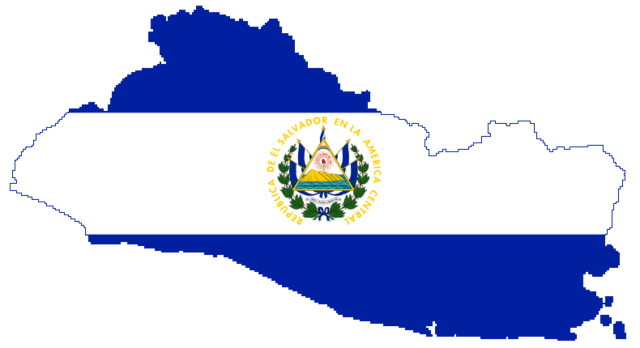
Culture & Heritage
El Salvador’s culture and heritage are colorful amalgamations of indigenous traditions, Spanish influences, and modern interpretations.
The nation is extremely proud of its pre-Columbian legacy, which includes illustrious archaeological sites like Joya de Cerén, a UNESCO World Heritage Site dubbed the “Pompeii of the Americas.” The everyday routines of the Mayan civilization, which formerly predominated in the area, are fascinatingly revealed by these ancient remains.
The magnificently maintained colonial architecture of towns like Suchitoto and Santa Ana demonstrates how much El Salvador values its colonial history. The country’s architectural magnificence may be seen in the majestic plazas, lovely cobblestone streets, and medieval churches.
History of El Salvador Flag
El Salvador’s political evolution, voyage through turbulent periods, and quest for independence are all entwined with the history of the flag.
Pre-Independence Period
El Salvador was a Spanish colony until it gained independence in 1821. The Spanish flag served as the region’s symbol throughout this time. However, the people of El Salvador yearned for their own unique sign as the winds of change started to sweep over Central America.
El Salvador joined the Federal Republic of Central America, a union of the five Central American nations, after gaining its independence. The horizontal blue and white stripes on the flag of this federation called the “Provincias Unidas del Centro de América,” were reminiscent of the current flag of El Salvador.
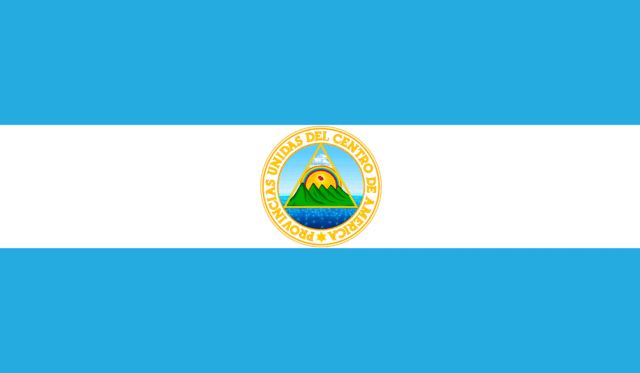
The Flag of the Federal Republic of Central America
During the Napoleonic Wars, the United Provinces of the Río de la Plata (Argentina) adopted a tricolor flag (blue-white-blue) to symbolize their sovereignty. The flag, which was briefly carried by Luís Aury in 1818, served as a source of inspiration for Spanish individuals residing in Central America. Central America declared independence in 1821 and reaffirmed it in 1823.
Colonel Manuel José Arce of El Salvador led the movement against Mexican rule, and his blue-white-blue flag became the national emblem of the United Provinces of Central America. This flag was declared the national flag of the United Provinces of Central America in 1822.
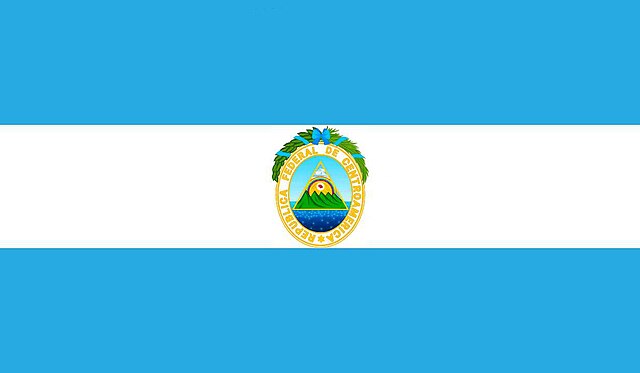
First National Flag
However, after the United Provinces of Central America dissolved into five separate countries in the 1840s, the flag underwent revision, and the previous tricolor El Salvador flag was replaced by a new design. The new flag featured nine blue and white stripes along with a red box positioned in the top left corner, adorned with nine white stars.
This particular flag with 9 stars served as the national flag of El Salvador until 1865. In 1875, an additional five stars were added to the flag, bringing the total to 14 stars. The flag, with its alternating stripes, pretty much resembled the United States flag.
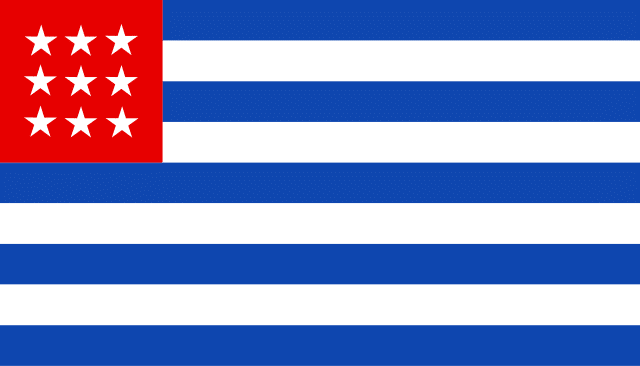
Modern Flag
The modern flag of El Salvador was introduced in 1912, featuring a blue-white-blue horizontal triband design with a coat of arms at the center, reminiscent of the flag of the Great Republic of Central America.
This flag, symbolizing Central American unity, was reintroduced on September 15, 1912, and has remained largely unchanged since then, with minor modifications made over the years, including the most recent update in September 1972.
The coat of arms within the flag bears resemblance to the one used by the former Central American federation and incorporates the national motto “Dios, unión, libertad” (“God, union, liberty”). The flag serves as a reminder of El Salvador’s history and its connection to the wider Central American region.
El Salvador’s flag still acts as a permanent symbol of national pride and a reminder of the country’s rich history. It serves as a representation of the nation’s development, tenacity, and continued efforts to bring about peace, unity, and prosperity for all of its citizens.
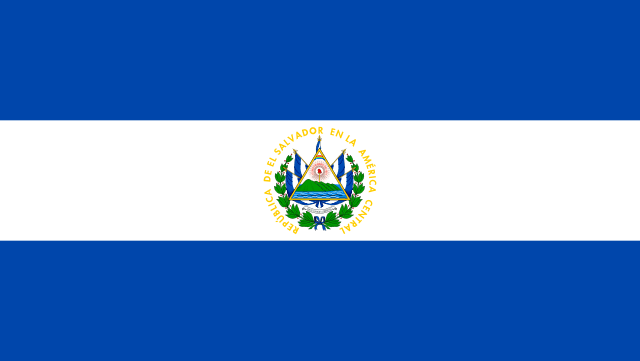
Design & Symbolism of El Salvador Flag
The El Salvador flag is a work of symbolism that captures the history, ambitions, and ideals of the country with its vibrant colors, geometric designs, and well-balanced proportions.
Three horizontal stripes, one cobalt blue at the top, one white in the center, and one cobalt blue at the bottom, make up the El Salvador flag. The Pacific Ocean to El Salvador’s south and the Caribbean Sea to its east are represented by the blue stripes. They underline the nation’s link to the huge bodies of water that surround it and serve as a symbol for the country’s geographic position.
Two times as wide as the blue stripes, the center white stripe stands for harmony, peace, and unification. It serves as a symbol of the country’s desire for peace and the harmony of its varied population. In addition, cleanliness, righteousness, and the desire for a wealthy future are connected to the color white.
The El Salvador flag’s crest is located in the middle of the white stripe. Five blue symbols are placed around a golden-yellow oval that is framed by a wreath made of laurel leaves. The laurel wreath stands for triumph and glory, while the oval signifies the peace and unity of the country.
The five blue emblems of the insignia stand for the five Central American nations that were a part of the Federal Republic of Central America from 1823 to 1841: Costa Rica, El Salvador, Guatemala, Honduras, and Nicaragua. Five five-pointed stars are aligned in an “X” form to depict the letter “E” for El Salvador in the symbols. They represent the historical ties between the country and its neighbors as well as the common values of liberty and cooperation.
El Salvador’s flag has a 5:8 aspect ratio, which means that its width is five units and its length is eight units. The flag may wave smoothly in the breeze and grab the attention of everyone who sees it thanks to this ratio, which guarantees a balanced and aesthetically pleasing design.
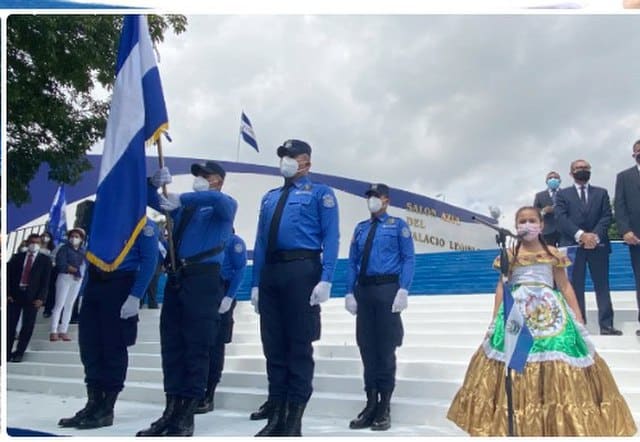
El Salvador Flag Protocol
Respect, dignity, and national pride are all demonstrated via flag protocol. There are certain rules and etiquette in El Salvador related to the flag that is observed on various occasions. Let’s look at El Salvador’s flag etiquette and some intriguing tidbits regarding the flag.
- El Salvador flag etiquette states that the flag should always be revered and respected.
- The flag should only be raised or lowered slowly and respectfully.
- The flag should be flown in a noticeable location, ideally on a flagpole or special flag stand.
- It should never be put on display when it is torn or discolored.
- Never should the flag rest on the ground or any other surface underneath it.
El Salvador Independence Day
Every September 15, El Salvador observes National Independence Day, which is often considered a flag day. It’s a significant event that holds historical and cultural significance for the country. This special occasion serves as a celebration of the Act of Independence of Central America, which took place on September 15, 1821. On this day, the Salvadoran people come together to honor and reflect upon their journey towards independence and the values that their national flag represents.
National Flag Day provides an opportunity for Salvadorans to consider their sense of solidarity and national identity. It serves as a reminder of the collective struggles, sacrifices, and achievements that have shaped their nation. The flag became a powerful symbol of unity and pride, representing the rich history, diverse heritage, and shared aspirations of the Salvadoran people.
Interesting Facts About El Salvador Flag
- President Francisco Dueas created El Salvador’s present flag in 1912.
- The flag’s blue and white hues are reminiscent of the old Central American country union known as the United Provinces of Central America.
- The flag’s insignia underwent a number of changes before coming to its ultimate form, which consists of a blue “E” symbol, laurel leaves, and a golden-yellow oval.
- The blue “E” on the logo stands for El Salvador, while the laurel leaves are a representation of triumph.
- The ratio of the flag is 5:8, which means that it is five units wide and eight units long.
- The biggest flag in the world, which is made in El Salvador, is more than 1,000 square meters. During a ceremony in 2019, it was unfurled.
Bottom Line
The El Salvador flag is a mighty symbol of togetherness, resilience, and optimism. It is a symbol of national identity and pride because of the way its vivid colors and significant symbols are woven into the history and culture of the nation. We hope that by the time we’ve finished our exploration of the El Salvador flag, you’ll have a deeper understanding of its significance and the stories it represents.